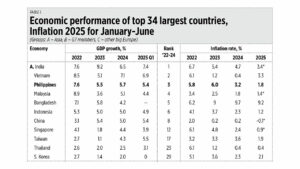On June 30, President Ferdinand R. Marcos, Jr. finished his third year in office. How has the Philippine economy performed during his administration compared with major economies in the world given continuing economic and global uncertainties?
To help answer this question I used four metrics or indicators: GDP growth, inflation rate, unemployment rate, and Debt/GDP ratio, and these are the results:
1. The Philippines was the third fastest growing economy among the top 34 largest economies in the world in terms of GDP size (at least $900 billion in 2024), average growth from 2022 to 2024. And even if extended to the top 50 largest economies, the Philippines was still the third fastest growing next to India and Vietnam. Malaysia, Bangladesh and Indonesia are 4th to 6th, Turkey is 7th, China is 8th. Egypt and Iran are 9th and 10th but I did not include them and several others in the accompanying table for the purpose of brevity.
2. The Philippines had among the highest inflation rates in Asia in 2022 to 2023, but this have been redeemed by low inflation rates of 3.2% in 2024 and 1.8% in January to June this year. When compared with G7 members and other big European countries, our inflation was mild, even in 2022, as they saw rates of 6-9% for G7 and 8-72% for other big European nations (see Table 1).
3. The Philippines’ unemployment rate has been on the decline, from 5.4% in 2022 to 3.9% in May 2025, which is lower than India, China, and Indonesia. It is also lower than the G7 members except Japan, and lower than other big European nations. Our labor force participation rate (LFPR) was a high of 65.8% in May 2025. The LFPR is an indicator of people’s optimism or pessimism about the labor market. If people think that there are more jobs available, they go out to seek jobs and the LFPR goes up. If people think there are few jobs available, they postpone joining the labor force and instead pursue more studies, or “standby” temporarily, and the LFPR goes down.
4. The Philippines’ public Debt/GDP ratio remained at 57% from 2021 to 2024. Half of the Asian countries in the list have reduced their ratios while half have increased. Those with ratios lower than 57% in 2024 are Indonesia, South Korea, Taiwan, and Vietnam (see Table 2).
So the Philippine economy under the Marcos Jr. administration has clearly performed well in three of four indicators — higher growth, lower inflation, lower unemployment — and has been neutral in the Debt/GDP ratio. Meaning that in the last three years, more Filipinos have experienced a higher standard of living, more stable prices, and have had more jobs to choose from.
The President’s economic team — led by Finance Secretary Ralph G. Recto, Economics Secretary Arsenio M. Balisacan, and Budget Secretary Amenah F. Pangandaman — has done their work well, regardless of what the pessimists and detractors claim.
In the next three years we should catch up when it comes to high growth with leaders Vietnam and India. Vietnam reported their second quarter (Q2) 2025 GDP and it is a whooping 8%, from an already high growth of 7.3% in Q2 2024 and 6.9% in Q1 2025.
Bienvenido S. Oplas, Jr. is the president of Bienvenido S. Oplas, Jr. Research Consultancy Services, and Minimal Government Thinkers. He is an international fellow of the Tholos Foundation.
minimalgovernment@gmail.com

